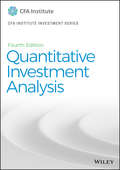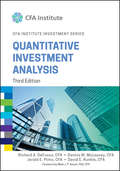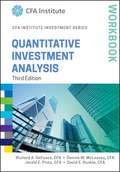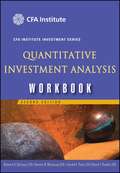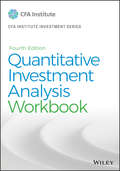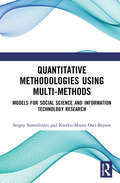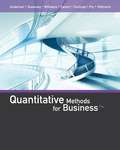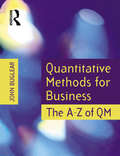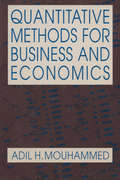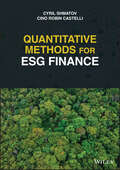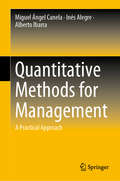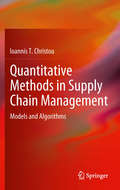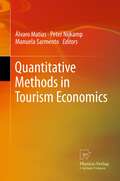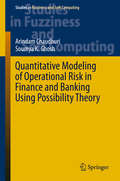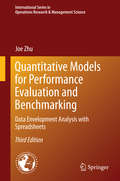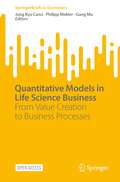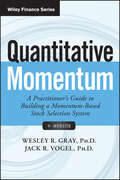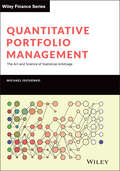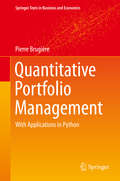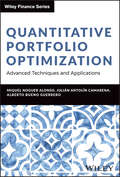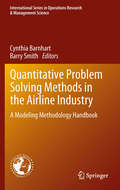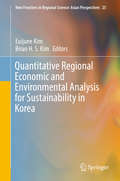- Table View
- List View
Quantitative Investment Analysis (CFA Institute Investment Series #123)
by CFA InstituteWhether you are a novice investor or an experienced practitioner, Quantitative Investment Analysis, 4th Edition has something for you. Part of the CFA Institute Investment Series, this authoritative guide is relevant the world over and will facilitate your mastery of quantitative methods and their application in today’s investment process. This updated edition provides all the statistical tools and latest information you need to be a confident and knowledgeable investor. This edition expands coverage to Machine Learning algorithms and the role of Big Data in an investment context along with capstone chapters in applying these techniques to factor modeling, risk management and backtesting and simulation in investment strategies. The authors go to great lengths to ensure an even treatment of subject matter, consistency of mathematical notation, and continuity of topic coverage that is critical to the learning process. Well suited for motivated individuals who learn on their own, as well as general reference, this complete resource delivers clear, example-driven coverage of a wide range of quantitative methods. Inside you’ll find: Learning outcome statements (LOS) specifying the objective of each chapter A diverse variety of investment-oriented examples both aligned with the LOS and reflecting the realities of today’s investment world A wealth of practice problems, charts, tables, and graphs to clarify and reinforce the concepts and tools of quantitative investment management Sharpen your skills by furthering your hands-on experience in the Quantitative Investment Analysis Workbook, 4th Edition—an essential guide containing learning outcomes and summary overview sections, along with challenging problems and solutions.
Quantitative Investment Analysis (CFA Institute Investment Series)
by Mark J. Anson Jerald E. Pinto Dennis W. McLeavey David E. Runkle DeFuscoYour complete guide to quantitative analysis in the investment industry Quantitative Investment Analysis, Third Edition is a newly revised and updated text that presents you with a blend of theory and practice materials to guide you through the use of statistics within the context of finance and investment. With equal focus on theoretical concepts and their practical applications, this approachable resource offers features, such as learning outcome statements, that are targeted at helping you understand, retain, and apply the information you have learned. Throughout the text's chapters, you explore a wide range of topics, such as the time value of money, discounted cash flow applications, common probability distributions, sampling and estimation, hypothesis testing, and correlation and regression. Applying quantitative analysis to the investment process is an important task for investment pros and students. A reference that provides even subject matter treatment, consistent mathematical notation, and continuity in topic coverage will make the learning process easier—and will bolster your success. Explore the materials you need to apply quantitative analysis to finance and investment data—even if you have no previous knowledge of this subject area Access updated content that offers insight into the latest topics relevant to the field Consider a wide range of subject areas within the text, including chapters on multiple regression, issues in regression analysis, time-series analysis, and portfolio concepts Leverage supplemental materials, including the companion Workbook and Instructor's Manual, sold separately Quantitative Investment Analysis, Third Edition is a fundamental resource that covers the wide range of quantitative methods you need to know in order to apply quantitative analysis to the investment process.
Quantitative Investment Analysis Workbook (CFA Institute Investment Series)
by Jerald E. Pinto Richard A. DeFusco Dennis W. McLeavey David E. RunkleHands-on quantitative analysis practice based on real-world scenarios The Quantitative Investment Analysis Workbook provides a key component of effective learning: practice. As the companion piece to Quantitative Investment Analysis, this workbook aligns with the text chapter-by-chapter to give you the focused, targeted exercises you need to fully understand each topic. Each chapter explicitly lays out the learning objectives so you understand the 'why' of each problem, and brief chapter summaries help refresh your memory on key points before you begin working. The practice problems themselves reinforce the practitioner-oriented text, and are designed to mirror the real-world problems encountered every day in the field. Solutions are provided to all of the problems for those who self-study, and an optional online Instructor's manual brings this book into the classroom with ease. Quantitative analysis is essential to the investment process, but hypothetical 'pie-in-the-sky' type practice scenarios only waste your time. You need a globally relevant application guide with roots in the real-world industry, so you can spend your time preparing for scenarios that you'll actually encounter. This workbook is your answer, with practice problems covering the complete range of quantitative methods. Refresh your memory with succinct chapter summaries Enhance your understanding with topic-specific practice problems Work toward explicit chapter objectives to internalize key information Practice important techniques with real-world applications Consistent mathematical notation, topic coverage continuity, and evenness of subject matter treatment are critical to the learning process. This workbook lives up to its reputation of clarity, and provides investment-oriented practice based on actual changes taking place in the global investment community. For those who want a practical route to mastering quantitative methods, the Quantitative Investment Analysis Workbook is your real-world solution.
Quantitative Investment Analysis, Workbook
by Richard A. David E. Dennis W. Jerald E. Defusco Mcleavey Pinto Runkle Anson Mark J.In Quantitative Investment Analysis Workbook, Second Edition, financial experts Richard DeFusco, Dennis McLeavey, Jerald Pinto, and David Runkle offer you a wealth of practical information and exercises that will further enhance your understanding of this discipline. This essential study guide-which parallels the main book chapter by chapter-contains challenging problems and a complete set of solutions as well as concise learning outcome statements and summary overviews.
Quantitative Investment Analysis, Workbook (CFA Institute Investment Series #126)
by CFA InstituteThe thoroughly revised and updated fourth edition of the companion workbook to Quantitative Investment Analysis is here. Now in its fourth edition, the Quantitative Investment Analysis Workbook offers a range of practical information and exercises that will facilitate your mastery of quantitative methods and their application in today's investment process. Part of the reputable CFA Institute Investment Series, the workbook is designed to further your hands-on experience with a variety of learning outcomes, summary overview sections, and challenging problems and solutions. The workbook provides all the statistical tools and latest information to help you become a confident and knowledgeable investor, including expanded problems on Machine Learning algorithms and the role of Big Data in investment contexts. Well suited for motivated individuals who learn on their own, as well as general reference, this companion resource delivers a clear, example-driven method for practicing the tools and techniques covered in the primary Quantitative Investment Analysis, 4th Edition text. Inside you’ll find information and exercises to help you: Work real-world problems associated with the modern quantitative investment process Review the fundamentals of single linear and multiple linear regression Use multifactor models Measure and manage market risk effectively Master data summarization and visualization In both the workbook and the primary Quantitative Investment Analysis, 4th Edition text, the authors go to great lengths to ensure an even treatment of subject matter, consistency of mathematical notation, and continuity of topic coverage that is critical to the learning process. For everyone who requires a streamlined route to mastering quantitative methods in investments, Quantitative Investment Analysis Workbook, 4th Edition offers world-class practice based on actual scenarios faced by professionals every day.
Quantitative Methodologies using Multi-Methods: Models for Social Science and Information Technology Research
by Kweku-Muata Osei-Bryson Sergey SamoilenkoQuantitative Methodologies using Multi-Methods is a multifaceted book written to help researchers. It is a user-friendly introduction to the popular methods of data mining and data analysis. The book avoids getting involved into details that are more suitable for more advanced users; it is written for readers who have, at most, a surface-level knowledge of the methods presented in the book. The book also serves as an introductory guide to the subject of complementarity of the tools and techniques of data analysis. It shows how methods could be used in synergy to offer insights into the issues that could not be dissected by any single method alone. This text can also be used as a set of templates, where, given a set of research questions, the investigator could identify a set of methodological modules allowing for answering the research questions of interest. This is not entirely unlike the relationship between analysis and design phases of the systems development life cycle — where the "What?" of the analysis phase has to be translated into the "How" of the design phase. The book can guide the identification of modules (the "How") that are suitable for answering research questions (the "What"). It can aid in transitioning a conceptual domain of the research questions into a scaffolding of data analytic and data mining methods. The book is also a guide to exploring what data under investigation holds. For example, an investigator may use the methodological modules presented in this book to generate a set of preliminary questions which, after a careful consideration and a requisite culling, could be formulated into a set of questions consistent within a selected theory or a framework. Finally, the book can be used as a generator of new research questions. Applying every method in each of the book’s modules opens a new dimension ripe with follow-up questions such as, "Why is this so?" The answers to this question may provide new insight and lead to the development of a new theory.
Quantitative Methods for Business
by David R. Anderson Dennis J. Sweeney Thomas A. Williams Jeffrey D. Camm James J. Cochran Jeffrey W. Ohlmann Michael J. FryWritten for the current or future business professional, QUANTITATIVE METHODS FOR BUSINESS, 13E makes it easy for you to understand how you can most effectively use quantitative methods to make smart, successful decisions. The book's hallmark problem-scenario approach guides you step by step through the application of mathematical concepts and techniques.
Quantitative Methods for Business
by John BuglearQuantitative Methods for Business: The A-Z of QM will enable readers to:*Appreciate the significance of quantitative methods for businesses and the study of business*Understand and apply a wide range of quantitative techniques*Select appropriate quantitative techniques for data analysis, problem solving and decision making*Interpret and communicate the results of quantitative analysis
Quantitative Methods for Business and Economics
by Adil H. MouhammedThis book provides a brief yet rigorous introduction to various quantitative methods used in economic decision-making. It has no prerequisites other than high school algebra. The book begins with matrix algebra and calculus, which are then used in the book's core modes. Once the reader grasps matrix theory and calculus, the quantitative models can be understood easily, and for each model there are many solved examples related to business and economic applications.
Quantitative Methods for ESG Finance
by Cino Robin Castelli Cyril ShmatovA quantitative analyst&’s introduction to the theory and practice of ESG finance In Quantitative Methods for ESG Finance, accomplished risk and ESG experts Dr. Cyril Shmatov and Cino Robin Castelli deliver an incisive and essential introduction to the quantitative basis of ESG finance from a quantitative analyst&’s perspective. The book combines the theoretical and mathematical bases underlying risk factor investing and risk management with accessible discussions of ESG applications. The authors explore the increasing availability of non-traditional data sources for quantitative analysts and describe the quantitative/statistical techniques they&’ll need to make practical use of these data. The book also offers: A particular emphasis on climate change and climate risks, both due to its increasing general importance and accelerating regulatory change in the space Practical code examples in a Python Jupyter notebook that use publicly available data to demonstrate the techniques discussed in the book Expansive discussions of risk factor investing, portfolio construction, ESG scoring, new ESG-driven financial products, and new financial risk management applications, particularly those making use of the proliferation of &“alternative data&”, both text and imagesA must-read guide for quantitative analysts, investment managers, financial risk managers, investment bankers, and other finance professionals with an interest in ESG-driven investing, Quantitative Methods for ESG Finance will also earn a place on the bookshelves of graduate students of business and finance.
Quantitative Methods for Management: A Practical Approach
by Miguel Ángel Canela Inés Alegre Alberto IbarraThis book focuses on the use of quantitative methods for both business and management, helping readers understand the most relevant quantitative methods for managerial decision-making. Pursuing a highly practical approach, the book reduces the theoretical information to a minimum, so as to give full prominence to the analysis of real business problems.Each chapter includes a brief theoretical explanation, followed by a real-life managerial case that needs to be solved, which is accompanied by a corresponding Microsoft Excel® dataset. The practical cases and exercises are solved using Excel, and for each problem, the authors provide an Excel file with the complete solution and corresponding calculations, which can be downloaded easily from the book’s website. Further, in an appendix, readers can find solutions to the same problems, but using the R statistical language.The book represents a valuable reference guide for postgraduate, MBA and executive education students, as it offers a hands-on, practical approach to learning quantitative methods in a managerial context. It will also be of interest to managers looking for a practical and straightforward way to learn about quantitative methods and improve their decision-making processes.
Quantitative Methods in Finance: Exploring the Drivers of Sustainable Economic Growth in the EU (Sustainable Finance)
by Ştefan Cristian GherghinaThis book explores certain social and environmental drivers of sustainable economic growth for European Union countries (EU-27) and United Kingdom (UK) in the context of the UN 2030 Agenda for Sustainable Development. The author provides a comprehensive overview of the factors that impact and facilitate sustainable economic growth and discusses the complex set of factors involved in sustainable economic development. Special attention is given to quantitative frameworks and empirical modelling, with the main focus on panel data regression models and vector error correction model approach. Furthermore, the book develops ratings of sustainable economic growth for each of the explored countries, by employing data mining techniques such as principal component analysis. Also, the data envelopment analysis non-parametric methodology towards assessing sustainable economic growth is investigated, as well as the cluster analysis in order to classify the selected nations according to sustainable economic growth. The book appeals to policy-makers and academics targeting to learn more about the characteristics of sustainable economic growth.
Quantitative Methods in Supply Chain Management
by Ioannis T. ChristouQuantitative Methods in Supply Chain Management presents some of the most important methods and tools available for modeling and solving problems arising in the context of supply chain management. In the context of this book, "solving problems" usually means designing efficient algorithms for obtaining high-quality solutions. The first chapter is an extensive optimization review covering continuous unconstrained and constrained linear and nonlinear optimization algorithms, as well as dynamic programming and discrete optimization exact methods and heuristics. The second chapter presents time-series forecasting methods together with prediction market techniques for demand forecasting of new products and services. The third chapter details models and algorithms for planning and scheduling with an emphasis on production planning and personnel scheduling. The fourth chapter presents deterministic and stochastic models for inventory control with a detailed analysis on periodic review systems and algorithmic development for optimal control of such systems. The fifth chapter discusses models and algorithms for location/allocation problems arising in supply chain management, and transportation problems arising in distribution management in particular, such as the vehicle routing problem and others. The sixth and final chapter presents a short list of new trends in supply chain management with a discussion of the related challenges that each new trend might bring along in the immediate to near future. Overall, Quantitative Methods in Supply Chain Management may be of particular interest to students and researchers in the fields of supply chain management, operations management, operations research, industrial engineering, and computer science.
Quantitative Methods in Tourism
by Jane Klobas Rodolfo BaggioTourism studies often deal with complex mixes of external and local factors and the attitudes, perceptions and actions of tourists themselves. In seeking to understand individual elements of this mix, or the results of interactions between them, tourism authorities, managers and researchers often collect quantitative data, but until now the few existing guides to understanding quantitative data have been either very simple or very complicated. This book provides a guide to dealing with real-world data and goes beyond the methods usually covered in introductory textbooks. The first part considers key issues associated with using well known methods to produce valid and reliable models of real-world phenomena, emphasizing issues in data selection, approaches to factor and cluster analysis, and mathematical modelling using regression methods (including logistic regression) and structural equation modelling. The second part covers new approaches to modelling: maximum likelihood estimation, simulation and agent-based modelling. Each chapter includes extensive references to additional reading, and an appendix summarises the software introduced in the book. The book provides many practical examples of applications to tourism research, considers practical issues associated with application of quantitative techniques, and discusses common pitfalls and how to identify and remedy them. The result is a guide to quantitative methods in tourism that de-mystifies both simple and apparently complex techniques and makes them more accessible to tourism researchers.
Quantitative Methods in Tourism Economics
by Peter Nijkamp Manuela Sarmento Álvaro MatiasTourism economics is partly based on established principles from the economics discipline, but it also incorporates elements from sociology, psychology, organization theory and ecology. It has over the years turned into an appealing multi-disciplinary oriented approach to the understanding of the impacts of leisure time in a modern society, including cultural heritage, sustainable quality of life, and industrial organization of the hospitality industry. The increasing dynamics in the tourist industry and its worldwide effects will continue to attract the attention of both the research and the policy sector in the years to come. Rather than speculating on non-observed facts, there is a clear need for evidence-based research in order to map out the complex dynamics of the tourist industry. The present volume comprises novel studies - mainly of a quantitative-analytical nature - on the supply, demand and contextual aspects of modern tourism. It contains a sound mix of theory, methodology, policy and case studies on various tourism issues in different parts of the world.
Quantitative Modeling of Operational Risk in Finance and Banking Using Possibility Theory
by Arindam Chaudhuri Soumya K. GhoshThis book offers a comprehensive guide to the modelling of operational risk using possibility theory. It provides a set of methods for measuring operational risks under a certain degree of vagueness and impreciseness, as encountered in real-life data. It shows how possibility theory and indeterminate uncertainty-encompassing degrees of belief can be applied in analysing the risk function, and describes the parametric g-and-h distribution associated with extreme value theory as an interesting candidate in this regard. The book offers a complete assessment of fuzzy methods for determining both value at risk (VaR) and subjective value at risk (SVaR), together with a stability estimation of VaR and SVaR. Based on the simulation studies and case studies reported on here, the possibilistic quantification of risk performs consistently better than the probabilistic model. Risk is evaluated by integrating two fuzzy techniques: the fuzzy analytic hierarchy process and the fuzzy extension of techniques for order preference by similarity to the ideal solution. Because of its specialized content, it is primarily intended for postgraduates and researchers with a basic knowledge of algebra and calculus, and can be used as reference guide for research-level courses on fuzzy sets, possibility theory and mathematical finance. The book also offers a useful source of information for banking and finance professionals investigating different risk-related aspects.
Quantitative Models for Performance Evaluation and Benchmarking
by Joe ZhuThe author is one of the prominent researchers in the field of Data Envelopment Analysis (DEA), a powerful data analysis tool that can be used in performance evaluation and benchmarking. This book is based upon the author's years of research and teaching experiences. It is difficult to evaluate an organization's performance when multiple performance metrics are present. The difficulties are further enhanced when the relationships among the performance metrics are complex and involve unknown tradeoffs. This book introduces Data Envelopment Analysis (DEA) as a multiple-measure performance evaluation and benchmarking tool. The focus of performance evaluation and benchmarking is shifted from characterizing performance in terms of single measures to evaluating performance as a multidimensional systems perspective. Conventional and new DEA approaches are presented and discussed using Excel spreadsheets -- one of the most effective ways to analyze and evaluate decision alternatives. The user can easily develop and customize new DEA models based upon these spreadsheets. DEA models and approaches are presented to deal with performance evaluation problems in a variety of contexts. For example, a context-dependent DEA measures the relative attractiveness of similar operations/processes/products. Sensitivity analysis techniques can be easily applied, and used to identify critical performance measures. Two-stage network efficiency models can be utilized to study performance of supply chain. DEA benchmarking models extend DEA's ability in performance evaluation. Various cross efficiency approaches are presented to provide peer evaluation scores. This book also provides an easy-to-use DEA software -- DEAFrontier. This DEAFrontier is an Add-In for Microsoft® Excel and provides a custom menu of DEA approaches. This version of DEAFrontier is for use with Excel 97-2013 under Windows and can solve up to 50 DMUs, subject to the capacity of Excel Solver. It is an extremely powerful tool that can assist decision-makers in benchmarking and analyzing complex operational performance issues in manufacturing organizations as well as evaluating processes in banking, retail, franchising, health care, public services and many other industries.
Quantitative Models in Life Science Business: From Value Creation to Business Processes (SpringerBriefs in Economics)
by Jung Kyu Canci Philipp Mekler Gang MuThis open access book explores the field of life science business from a multidisciplinary perspective. Applying statistical, mathematical, game-theoretic, and data science tools to pharmaceutical and biotechnology business endeavors, the book describes value creation, value maintenance, and value realization in the life sciences as a sequence of processes using the quantitative language of applied mathematics. Written by experts from a variety of fields, the contributions illustrate the shift from a deterministic to a stochastic view of the processes involved, offering a new perspective on life sciences economics. The book covers topics such as valuing and managing intellectual property in life science, licensing in the pharmaceutical business, outsourcing pharmaceutical R&D, and stochastic modelling of a pharmaceutical supply chain. The book will appeal to scholars of economics and the life sciences, as well as to professionals in chemical and pharmaceutical industries.
Quantitative Momentum: A Practitioner's Guide to Building a Momentum-Based Stock Selection System (Wiley Finance)
by Wesley R. Gray Jack R. VogelThe individual investor's comprehensive guide to momentum investing Quantitative Momentum brings momentum investing out of Wall Street and into the hands of individual investors. In his last book, Quantitative Value, author Wes Gray brought systematic value strategy from the hedge funds to the masses; in this book, he does the same for momentum investing, the system that has been shown to beat the market and regularly enriches the coffers of Wall Street's most sophisticated investors. First, you'll learn what momentum investing is not: it's not 'growth' investing, nor is it an esoteric academic concept. You may have seen it used for asset allocation, but this book details the ways in which momentum stands on its own as a stock selection strategy, and gives you the expert insight you need to make it work for you. You'll dig into its behavioral psychology roots, and discover the key tactics that are bringing both institutional and individual investors flocking into the momentum fold. Systematic investment strategies always seem to look good on paper, but many fall down in practice. Momentum investing is one of the few systematic strategies with legs, withstanding the test of time and the rigor of academic investigation. This book provides invaluable guidance on constructing your own momentum strategy from the ground up. Learn what momentum is and is not Discover how momentum can beat the market Take momentum beyond asset allocation into stock selection Access the tools that ease DIY implementation The large Wall Street hedge funds tend to portray themselves as the sophisticated elite, but momentum investing allows you to 'borrow' one of their top strategies to enrich your own portfolio. Quantitative Momentum is the individual investor's guide to boosting market success with a robust momentum strategy.
Quantitative Operational Risk Models (Chapman & Hall/CRC Finance Series)
by Catalina Bolance Montserrat Guillén Jim Gustafsson Jens Perch NielsenUsing real-life examples from the banking and insurance industries, Quantitative Operational Risk Models details how internal data can be improved based on external information of various kinds. Using a simple and intuitive methodology based on classical transformation methods, the book includes real-life examples of the combination of internal dat
Quantitative Portfolio Management: The Art and Science of Statistical Arbitrage
by Michael IsichenkoDiscover foundational and advanced techniques in quantitative equity trading from a veteran insider In Quantitative Portfolio Management: The Art and Science of Statistical Arbitrage, distinguished physicist-turned-quant Dr. Michael Isichenko delivers a systematic review of the quantitative trading of equities, or statistical arbitrage. The book teaches you how to source financial data, learn patterns of asset returns from historical data, generate and combine multiple forecasts, manage risk, build a stock portfolio optimized for risk and trading costs, and execute trades. In this important book, you’ll discover: Machine learning methods of forecasting stock returns in efficient financial markets How to combine multiple forecasts into a single model by using secondary machine learning, dimensionality reduction, and other methods Ways of avoiding the pitfalls of overfitting and the curse of dimensionality, including topics of active research such as “benign overfitting” in machine learning The theoretical and practical aspects of portfolio construction, including multi-factor risk models, multi-period trading costs, and optimal leverage Perfect for investment professionals, like quantitative traders and portfolio managers, Quantitative Portfolio Management will also earn a place in the libraries of data scientists and students in a variety of statistical and quantitative disciplines. It is an indispensable guide for anyone who hopes to improve their understanding of how to apply data science, machine learning, and optimization to the stock market.
Quantitative Portfolio Management: with Applications in Python (Springer Texts in Business and Economics)
by Pierre BrugièreThis self-contained book presents the main techniques of quantitative portfolio management and associated statistical methods in a very didactic and structured way, in a minimum number of pages. The concepts of investment portfolios, self-financing portfolios and absence of arbitrage opportunities are extensively used and enable the translation of all the mathematical concepts in an easily interpretable way. All the results, tested with Python programs, are demonstrated rigorously, often using geometric approaches for optimization problems and intrinsic approaches for statistical methods, leading to unusually short and elegant proofs. The statistical methods concern both parametric and non-parametric estimators and, to estimate the factors of a model, principal component analysis is explained. The presented Python code and web scraping techniques also make it possible to test the presented concepts on market data. This book will be useful for teaching Masters students and for professionals in asset management, and will be of interest to academics who want to explore a field in which they are not specialists. The ideal pre-requisites consist of undergraduate probability and statistics and a familiarity with linear algebra and matrix manipulation. Those who want to run the code will have to install Python on their pc, or alternatively can use Google Colab on the cloud. Professionals will need to have a quantitative background, being either portfolio managers or risk managers, or potentially quants wanting to double check their understanding of the subject.
Quantitative Portfolio Optimization: Advanced Techniques and Applications (Wiley Finance)
by Miquel Noguer Alonso Julian Antolin Camarena Alberto Bueno GuerreroExpert guidance on implementing quantitative portfolio optimization techniques In Quantitative Portfolio Optimization: Theory and Practice, renowned financial practitioner Miquel Noguer, alongside physicists Alberto Bueno Guerrero and Julian Antolin Camarena, who possess excellent knowledge in finance, delve into advanced mathematical techniques for portfolio optimization. The book covers a range of topics including mean-variance optimization, the Black-Litterman Model, risk parity and hierarchical risk parity, factor investing, methods based on moments, and robust optimization as well as machine learning and reinforcement technique. These techniques enable readers to develop a systematic, objective, and repeatable approach to investment decision-making, particularly in complex financial markets. Readers will gain insights into the associated mathematical models, statistical analyses, and computational algorithms for each method, allowing them to put these techniques into practice and identify the best possible mix of assets to maximize returns while minimizing risk. Topics explored in this book include: Specific drivers of return across asset classes Personal risk tolerance and it#s impact on ideal asses allocation The importance of weekly and monthly variance in the returns of specific securities Serving as a blueprint for solving portfolio optimization problems, Quantitative Portfolio Optimization: Theory and Practice is an essential resource for finance practitioners and individual investors It helps them stay on the cutting edge of modern portfolio theory and achieve the best returns on investments for themselves, their clients, and their organizations.
Quantitative Problem Solving Methods in the Airline Industry
by Barry Smith Cynthia BarnhartThis book reviews Operations Research theory, applications and practice in seven major areas of airline planning and operations. In each area, a team of academic and industry experts provides an overview of the business and technical landscape, a view of current best practices, a summary of open research questions and suggestions for relevant future research. There are several common themes in current airline Operations Research efforts. First is a growing focus on the customer in terms of: 1) what they want; 2) what they are willing to pay for services; and 3) how they are impacted by planning, marketing and operational decisions. Second, as algorithms improve and computing power increases, the scope of modeling applications expands, often re-integrating processes that had been broken into smaller parts in order to solve them in the past. Finally, there is a growing awareness of the uncertainty in many airline planning and operational processes and decisions. Airlines now recognize the need to develop 'robust' solutions that effectively cover many possible outcomes, not just the best case, "blue sky" scenario. Individual chapters cover: Customer Modeling methodologies, including current and emerging applications. Airline Planning and Schedule Development, with a look at many remaining open research questions. Revenue Management, including a view of current business and technical landscapes, as well as suggested areas for future research. Airline Distribution -- a comprehensive overview of this newly emerging area. Crew Management Information Systems, including a review of recent algorithmic advances, as well as the development of information systems that facilitate the integration of crew management modeling with airline planning and operations. Airline Operations, with consideration of recent advances and successes in solving the airline operations problem. Air Traffic Flow Management, including the modeling environment and opportunities for both Air Traffic Flow Management and the airlines.
Quantitative Regional Economic and Environmental Analysis for Sustainability in Korea
by Euijune Kim Brian H. S. KimThis book focuses on the application of newly innovated analytical tools for sustainable development on regional economic and environmental issues in Korea. With a range of case studies, the authors explore a series of theoretical models and empirical methods including spatial CCE Model, multiregional Input-Output and econometric analysis, logit model, contingent valuation method, GIS, sample selection model, machine learning technique, stochastic frontier analysis, and panel analysis. These models and methods are tailored to spatial development issues such as agglomeration, clustering and industrial innovation, human capital and labor market, education and R&D investments and economic resilience for regional economies and unexpected disaster, and natural resources for environmental markets. Quantitative Regional Economic and Environmental Analysis for Sustainability in Korea is of particular interest to policy makers and practitioners, as well as research scholars active in sustainability science.
